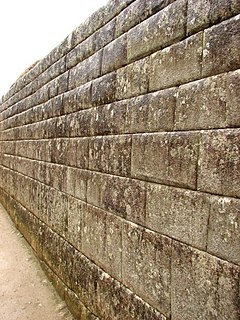
The Latin word basilica has three distinct applications in modern English.

Walsingham is a village in North Norfolk, England, famous for its religious shrines in honour of the Virgin Mary. It also contains the ruins of two medieval monastic houses.

Iseo is a town and comune in the province of Brescia, in Lombardy, Italy, on the south shore of Lake Iseo. It is bounded by the communes of Provaglio d'Iseo, Sulzano, Polaveno and Paratico.

Chipiona is a town and municipality located on the Atlantic coast in the province of Cádiz, Spain. According to the 2012 census, the city has a population of 18,849 inhabitants, but this amount increases greatly during the summer holiday period. The town covers an area of 33 km². Being in the lower valley of the River Guadalquivir it is very flat with a maximum terrestrial height of 4 metres. It is bordered on the north-west by Sanlúcar de Barrameda and on the south-east by the port of Rota.

Ħaġar Qim is a megalithic temple complex found on the Mediterranean island of Malta, dating from the Ġgantija phase (3600-3200 BC). The Megalithic Temples of Malta are among the most ancient religious sites on Earth, described by the World Heritage Sites committee as "unique architectural masterpieces." In 1992 UNESCO recognized Ħaġar Qim and four other Maltese megalithic structures as World Heritage Sites. V. Gordon Childe, Professor of Prehistoric European Archeology and director of the Institute of Archaeology in the University of London from 1946-1957 visited Ħaġar Qim. He wrote, "I have been visiting the prehistoric ruins all round the Mediterranean, from Mesopotamia to Egypt, Greece and Switzerland, but I have nowhere seen a place as old as this one."

Fermo[ˈfermo]listen (help·info) is a town and comune of the Marche, Italy, in the Province of Fermo.

Chittlehampton is a village and civil parish in the North Devon district of Devon, England. The parish is surrounded clockwise from the north by the parishes of Swimbridge, Filleigh, South Molton, Satterleigh and Warkleigh, High Bickington, Atherington, and Bishop's Tawton. According to the 2001 census, the parish had a population of 820. There is an electoral ward of the same name. In the 2011 census this ward had a population of 2,255.

The Pyramid of Senusret I is an Egyptian pyramid built to be the burial place of the Pharaoh Senusret I. The pyramid was built during the Twelfth Dynasty of Egypt at el-Lisht, near the pyramid of his father, Amenemhat I. Its ancient name was Senusret Petei Tawi.

Struell Wells are a set of four holy wells in the townland of Struell, 1.5 miles (2.4 km) east of Downpatrick, County Down, Northern Ireland. The wells date from before the time of Saint Patrick, and even today are used for people seeking cures. On Mid-Summer Eve and the Friday before Lammas, hundreds of pilgrims used to visit Struell. The earliest written reference to the wells is in 1306, but none of the surviving buildings is earlier than about 1600. Pilgrimages to the site are well documented from the 16th century to the 19th century. The site is managed by the Northern Ireland Environment Agency.

Penrhys is a village in the county borough of Rhondda Cynon Taf, Wales, situated on a hillside overlooking both valleys of Rhondda Fawr and Rhondda Fach. It is situated around 1,100 ft above sea level and is a district of Tylorstown. Until the late 16th century, Penrhys was one of the holiest sites for Christian pilgrims in Wales.
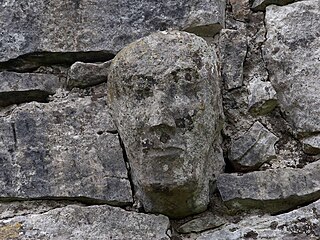
Temple Cronan is a ruined medieval oratory or chapel built near a holy well in the Burren, County Clare, Ireland. The current building apparently dates from the 12th and 15th centuries, although it may partly incorporate earlier buildings or some of the masonry thereof. It may have been the site of an early Christian monastery. Temple Cronan is located in the civil parish of Carran, eight miles from Corofin and about sixteen miles from Ennis.

The Loughinisland Churches are the remains of three ruined churches in Loughinisland, County Down, Northern Ireland, dating from the 13th to the 17th centuries. They are situated in Tievenadarragh townland, in a large graveyard on an island in Loughinisland Lake, now reached by a causeway. The churches are state-care historic monuments at grid ref: J4234 4537.
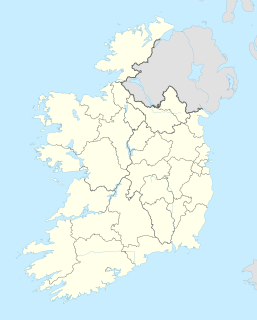
Stonetown is a small rural community in the parish of Louth 10 kilometres from Dundalk, County Louth, and 11 kilometres from Carrickmacross, County Monaghan. The community consists of a small chapel, a primary school, a football field and a community centre.

Cuetlajuchitlán is a Mesoamerican archaeological site located 3 kilometers southeast of Paso Morelos, in the northeast of the Mexican state of Guerrero.
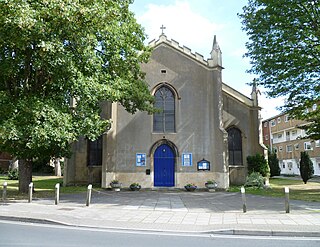
St Mary de Lode Church is a Church of England church immediately outside the grounds of Gloucester Cathedral. It is believed by some to be on the site of the first Christian church in Britain. The church is in the Diocese of Gloucester and Grade I listed by English Heritage. It has also been known as St. Mary Before the Gate of St. Peter, St. Mary Broad Gate and St. Mary De Port.
Lady's Well or Our Lady's Well is a common name in the United Kingdom and Ireland for a holy well, usually dedicated to the Virgin Mary.

Kings Walk Shopping Centre is a single-storey indoor shopping centre in Gloucester, England. Built between 1969 and 1972, it is part of the Kings Quarter development that includes an outdoor pedestrianised area.

St Margaret's Well (NT271737) is a Category B listed holy well that was relocated to Holyrood Park off Queen's Drive, Edinburgh from Restalrig in 1860. It is one of seven wells located in the park.
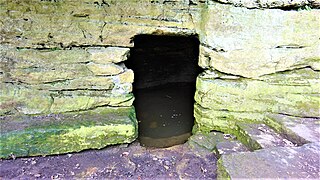
The early 13th century St Robert's Cave and Chapel of the Holy Cross also known with variants such as St Robert's Chapel and Chapel of the Holy Rood are located on Abbey Road beside the River Nidd in its gorge at Knaresborough. The cave is a rare example of a medieval hermitage, cut out of the magnesian limestone river gorge with a domestic area externally and the chapel of the Holy Cross which originally housed the saint's grave. For consistency the term 'cave' will be used throughout.
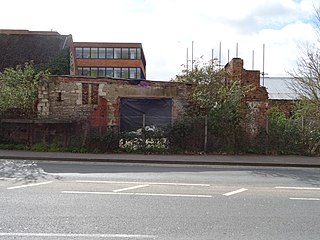
Tanners Hall was a 13th century town house and is now a ruin located on Gouda Way in Gloucester. It is the oldest non-religious building and only surviving medieval domestic stone house in the city. It became a Grade II listed building on 29 July 2015.







